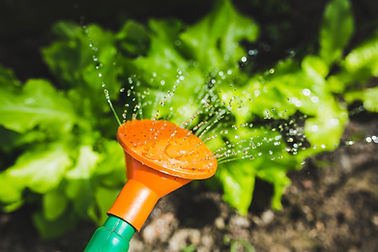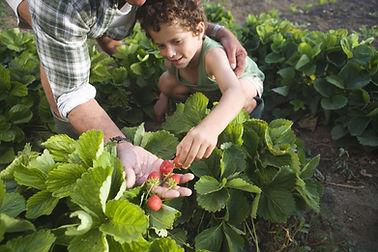

Setting up a School Garden
If appropriately planned, the school garden can be a stimulating and motivating place. It allows pupils or students to become more actively involved in their outdoor surroundings.
Before considering a school garden...
Identify a location for the garden

Find plans of the chosen site, available from the (Local Education Authority) LEA, to determine whether there are any services underneath the surface, or contaminants from previous land use that you should be aware of
Look at legal, technical, safety guidelines and school policy documents as required
Consider when you want the garden to be completed by, and produce an action plan
Establish a group to move the project forwards and decide who will project- manage the design and building of the garden and who will maintain it later
Incorporate the project into the school development plan
Find out if any of the skills needed exist in the school community, parents, governors or the friends/PTA, for example gardeners, garden designers or builders
Share the vision. Engage everyone in the school community – managers, staff, parents and pupils. Make everyone aware of the potential of a school garden and the benefits your school will gain from using it
Survey the site
Get the children involved in carrying out a survey to see what they want. walk around it, see what you have there
- Establish the orientation of the site (N, S, E and W). What are the sunny / shady areas (in summer and in winter)? This will influence what crops you might plant and where
- What type of soil do you have (clay, sand or silt, etc)? link to: Soil test by hand & soil terms.
- Where do the winds come from? Are there any natural windbreaks, or could you install some? This will influence what crops you might plant and where
- How far is your water source and can you collect rainwater on site?
- Access to toilets
- The distance from the classrooms
- Storage of equipment
- Where will your composting area(s) be? What kind of composting structures can you have?
- Are there paths or sheds you need to keep?
- Are there any plants that could still be used?
- What trees do you have? Check to see if any of the trees are protected by preservation orders or are in a conservation area
- Ensure risk assessments are completed before any work is started in the garden.


Establish the purpose of the garden.
Is it to attract wildlife or to become an environmental area?
Do you want to grow produce or herbs?
Is it to be a sensory garden?
Is it to provide shade?
Will it be to teach certain subjects outdoors such as science, geography, maths or english?
Will it be for pupils, staff, parents and the local community to use?
Or is it for a memorial garden that needs a calming and quiet feel?
Decide on shape and position of planting beds
Narrow beds (no more than 120cm in width) are good for children as they can reach the middle for planting and weeding from both sides without compacting the soil.
If the beds are only accessible from one side then they should be no more than 60cm in width.
Do you need raised beds and disabled access?

Incorporate sustainability into the garden design

Try to include a compost heap and water butt.
Will it be organic? Chemicals are best avoided where there is the possibility of children either attempting to eat plant parts or putting fingers in their mouths. Be cautious if using animal manures as fertilisers.
Natural liquid plant feeds can be made from nettles or comfrey.
Can you recycle anything to use in your garden to make a feature?
Old tree stumps can be sculptured to provide a focal point.
Reuse items such as containers in which plants can be grown.
Choose plants suitable for your site and conditions. This may take a little more time, but it will be worth it in the long run and you will not have the disappointment of sickly or dead plants. e.g. if you have a very dry, sunny and warm garden you could create a dry garden.
Consider those with special needs in your design
The priority is to design entrances, outdoor paths and hard surfaces to accommodate as full a range of needs as possible and to ensure that no children are denied access to the opportunities and activities that the garden offers.
Distance is also an important consideration for children with limited stamina, and there should be things of interest in the school grounds that are near to the school building.
Use a combination of surfaces with different textures as you move from one area to another in the garden. This aids orientation for partially sighted people and also makes the garden more interesting.
Make the paths wide enough for wheelchairs (at least 120cm or 180cm so that two wheelchairs can pass).
Consider carefully what materials are used for the surfaces of the paths, they need to be firm, even and nonslip. Self-binding gravel is less harsh than tarmac or concrete. Find out more information about how to garden with special needs.


Implementing your plan
Clear the site of weeds and rubbish. Be careful at this stage if you involve children. There may be hidden dangers.
Be aware of potentially harmful plants when gardening and ensure gloves are always worn.
Try to involve the children as much as possible in the garden build as this helps them form a feeling of ownership and care towards it.
Can you start to grow plants inside and bring them outside when they are established?
Ideas for finding funding
You could write letters to parents, garden centres, seed companies and supermarkets asking for donations of money towards the school garden, plants, seeds, tools or help. Ask your pupils to write the letters as a literacy task.
Don’t forget - you need tools. You may require specially adapted tools.
You can even grow plants to raise money, just follow our enterprise ideas.


When designing the garden think about:
Accessibility: Who will be using the garden? At what height? How many at once? What pathways are needed? Are there any additional needs you need to consider?
Can volunteers access the garden out of school hours?
The security of the site!
Visiting other schools that have done similar projects to gain ideas.
Don't feel you need to do everything at the start, leave space to grow the garden each season!
Maintaining the garden
Who will look after the garden? Don’t forget the school holidays!
How do you prevent vandalism? Involving the community in your garden project and giving children ownership of the garden help.
Keep the paths in good repair and make sure that there are no overhanging branches.
Remember to monitor and evaluate your garden and add to or improve and change it as and when necessary.
Don’t forget to keep records at each stage of the development –especially photographic ones. You may need these later to enter competitions or apply for funding.
Try to take your photos from the same spot throughout the development of the site and throughout the year as it shows your progress beautifully


Future Plans
Start realistically.
Build a team of support.
Explore volunteers to support the garden and your sessions regularly. Also to help with watering in the summer.
Link with other local schools and plan to visit and help each other.
Communication
Consider communications with parents, school governors and PTA across the year regarding what you need for the garden. Open days, Garden Parties, Donations and Clearance sessions can all be supported by other people from teh community in and outside the school.

